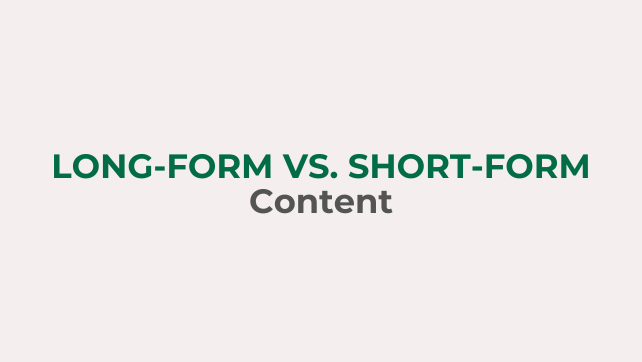Long-form vs. Short-form Content: Choosing the right format for your goals
Attention spans are shrinking, but does that mean short content always wins? Uncover the truth about long-form vs. short-form content and how to use both effectively.
In the dynamic digital landscape, where content reigns supreme, a crucial decision for every marketer is choosing the right format for their message. The age-old debate between long-form and short-form content continues, each with its unique strengths and ideal applications.
Long-Form Content: Diving deep
Long-form content, typically exceeding 1,000 words, is your strategic tool for establishing authority and providing in-depth value. Think of it as a deep-sea exploration, offering readers a comprehensive understanding of a specific topic. This format shines in the realm of:
Educational and pillar content: Detailed blog posts, guides, white papers, ebooks, and case studies fall under this category. They provide valuable insights, build trust, and showcase your brand's expertise.
SEO powerhouse: Long-form content allows you to incorporate a broader range of keywords, boosting your chances of ranking higher in search results. The sheer volume of information also signals to search engines that your content is comprehensive and valuable.
Backlinks and social shares: Studies suggest that long-form content attracts more backlinks and social shares, amplifying your reach and authority.
Conversions: Long-form content effectively nurtures leads through the marketing funnel, ultimately driving conversions.
Short-form Content: Snappy & engaging
Short-form content, usually under 1,000 words, focuses on delivering concise, impactful messages. It's perfect for grabbing attention in today's fast-paced digital world. Common types include:
Social media content: Posts, stories, and reels on platforms like Instagram, Twitter, and Facebook.
Infographics: Visually engaging representations of data or information.
Short videos: Snackable video content ideal for platforms like TikTok and Instagram Reels.
Emails: Newsletters, promotional offers, or updates delivered directly to your subscribers.
The benefits of Short-form:
Easy consumption: Perfect for capturing attention in a world of shrinking attention spans.
Brand awareness: Shareable and highly visible on social media, increasing brand awareness.
Quick answers: Ideal for providing concise information or addressing specific questions.
Immediate action: Designed to prompt quick actions like clicks or purchases.
Cost-effective: Generally quicker and less resource-intensive to produce.
Choosing the right format: A strategic approach
Deciding between long-form and short-form content requires careful consideration of several key factors:
Your goals: Are you aiming to build brand awareness, generate leads, drive conversions, or establish thought leadership? Each format serves specific goals.
Your platform: Adapt your content to the platform you're using. Social media thrives on short-form content, while your website can leverage both long- and short-form pieces.
Search intent: Align your content with the user's search intent. If they're seeking quick answers, short-form is ideal. For in-depth research, opt for long-form.
Audience preferences: Understand your audience's needs and tailor your content accordingly. Some might prefer detailed information, while others favor bite-sized snippets.
Topic complexity: Choose long-form for complex or technical subjects, and short-form for simpler, more straightforward topics.
The ideal content mix: A harmonious blend
The most successful content strategies embrace a blend of both long-form and short-form content.
Long-form content provides in-depth value, boosts SEO, and establishes authority.
Short-form content drives engagement, captures attention, and complements your long-form efforts.
By strategically using both formats, you'll create a powerful content ecosystem that fosters engagement, builds trust, and drives conversions.
Remember, the key is to understand your audience, set clear goals, and adapt your content strategy to their preferences and objectives. With a balanced mix of long-form and short-form content, you'll create a winning formula for your brand's success.



